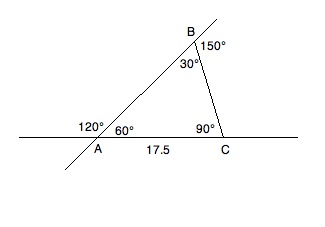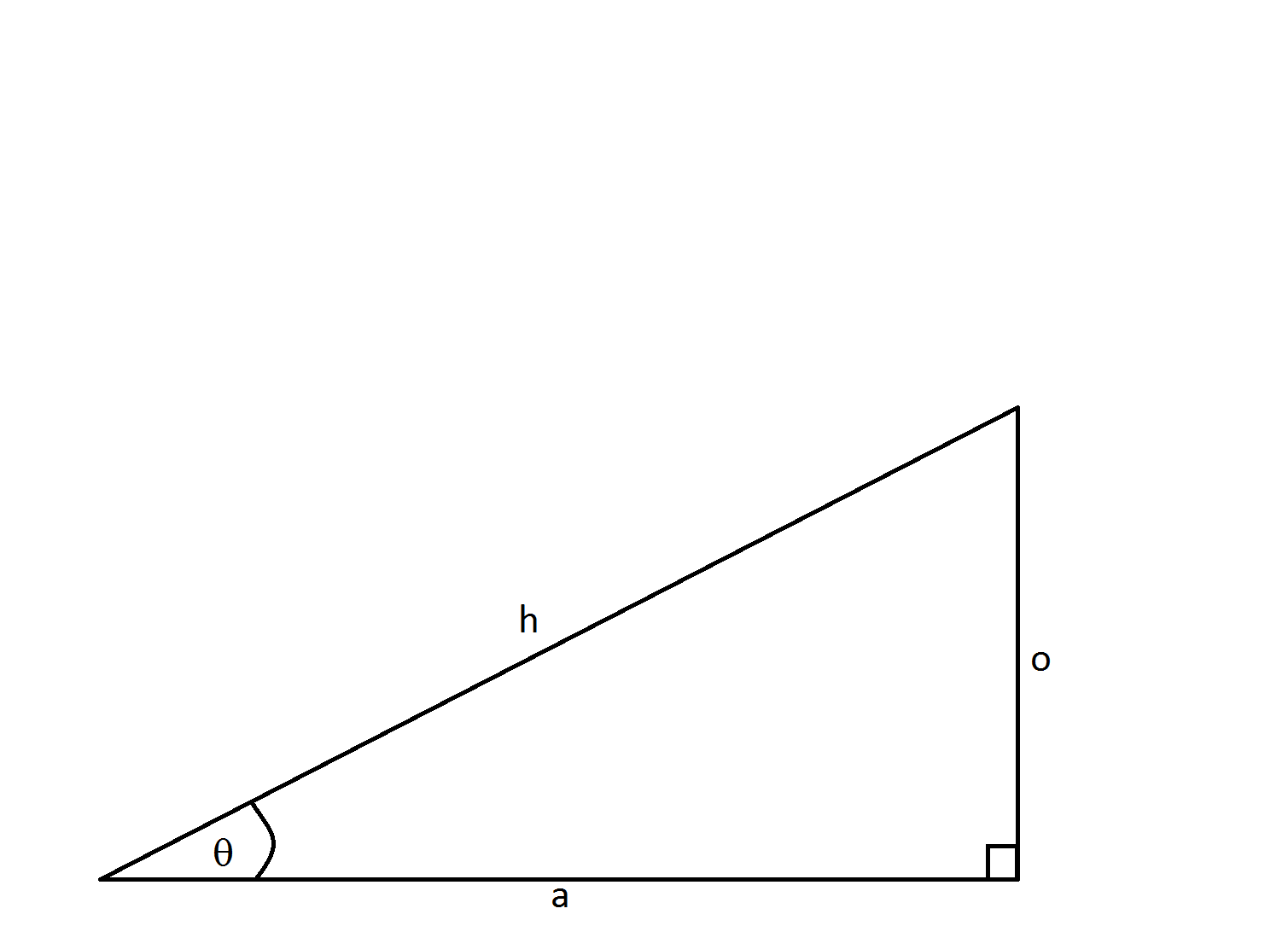All SAT Math Resources
Example Questions
Example Question #41 : Sat Mathematics
The vertices of a right triangle on the coordinate axes are at the origin, 

The triangle in question can be drawn as the following:

The lengths of the legs of the triangle are 12, the distance from the origin to 


Example Question #1 : How To Find The Perimeter Of A Right Triangle
Three points in the xy-coordinate system form a triangle.
The points are 
What is the perimeter of the triangle?
Drawing points gives sides of a right triangle of 4, 5, and an unknown hypotenuse.
Using the pythagorean theorem we find that the hypotenuse is 
Example Question #41 : Geometry

Based on the information given above, what is the perimeter of triangle ABC?

Consult the diagram above while reading the solution. Because of what we know about supplementary angles, we can fill in the inner values of the triangle. Angles A and B can be found by the following reductions:
A + 120 = 180; A = 60
B + 150 = 180; B = 30
Since we know A + B + C = 180 and have the values of A and B, we know:
60 + 30 + C = 180; C = 90
This gives us a 30:60:90 triangle. Now, since 17.5 is across from the 30° angle, we know that the other two sides will have to be √3 and 2 times 17.5; therefore, our perimeter will be as follows:
Example Question #41 : Geometry

Give the perimeter of the provided triangle.
The figure shows a right triangle. The acute angles of a right triangle have measures whose sum is 
Substituting 

This makes 
By the 45-45-90 Triangle Theorem, legs 


Also by the 45-45-90 Triangle Theorem, the length of hypotenuse



The perimeter of the triangle is
Example Question #44 : Sat Mathematics

What is the perimeter of the triangle above?
The figure shows a right triangle. The acute angles of a right triangle have measures whose sum is 
Substituting 

This makes 



Rationalize the denominator by multiplying both halves of the fraction by 
By the same reasoning, 
The perimeter of the triangle is
Example Question #1 : Apply The Pythagorean Theorem To Find The Distance Between Two Points In A Coordinate System: Ccss.Math.Content.8.G.B.8

If 


Not enough information to solve
This problem is solved using the Pythagorean theorem 



Using the labels of our triangle we have:
Example Question #41 : Right Triangles
If one of the short sides of a 45-45-90 triangle equals 5, how long is the hypotenuse?
5
5√2
√15
π
√10
5√2
Using the Pythagorean theorem, x2 + y2 = h2. And since it is a 45-45-90 triangle the two short sides are equal. Therefore 52 + 52 = h2 . Multiplied out 25 + 25 = h2.
Therefore h2 = 50, so h = √50 = √2 * √25 or 5√2.
Example Question #1 : How To Find The Length Of The Hypotenuse Of A Right Triangle : Pythagorean Theorem
The height of a right circular cylinder is 10 inches and the diameter of its base is 6 inches. What is the distance from a point on the edge of the base to the center of the entire cylinder?
None of the other answers
√(43)/2
3π/4
4π/5
√(34)
√(34)
The best thing to do here is to draw diagram and draw the appropiate triangle for what is being asked. It does not matter where you place your point on the base because any point will produce the same result. We know that the center of the base of the cylinder is 3 inches away from the base (6/2). We also know that the center of the cylinder is 5 inches from the base of the cylinder (10/2). So we have a right triangle with a height of 5 inches and a base of 3 inches. So using the Pythagorean Theorem 32 + 52 = c2. 34 = c2, c = √(34).
Example Question #1 : How To Find The Length Of The Hypotenuse Of A Right Triangle : Pythagorean Theorem
A right triangle with sides A, B, C and respective angles a, b, c has the following measurements.
Side A = 3in. Side B = 4in. What is the length of side C?
5
25
7
9
6
5
The correct answer is 5. The pythagorean theorem states that a2 + b2 = c2. So in this case 32 + 42 = C2. So C2 = 25 and C = 5. This is also an example of the common 3-4-5 triangle.
Example Question #5 : How To Find The Length Of The Hypotenuse Of A Right Triangle : Pythagorean Theorem
The lengths of the three sides of a right triangle form a set of consecutive even integers when arranged from least to greatest. If the second largest side has a length of x, then which of the following equations could be used to solve for x?
(x – 1)2 + x2 = (x + 1)2
(x – 2)2 + x2 = (x + 2)2
(x – 2) + x = (x + 2)
x 2 + (x + 2)2 = (x + 4)2
(x + 2)2 + (x – 2)2 = x2
(x – 2)2 + x2 = (x + 2)2
We are told that the lengths form a series of consecutive even integers. Because even integers are two units apart, the side lengths must differ by two. In other words, the largest side length is two greater than the second largest, and the second largest length is two greater than the smallest length.
The second largest length is equal to x. The second largest length must thus be two less than the largest length. We could represent the largest length as x + 2.
Similarly, the second largest length is two larger than the smallest length, which we could thus represent as x – 2.
To summarize, the lengths of the triangle (in terms of x) are x – 2, x, and x + 2.
In order to solve for x, we can make use of the fact that the triangle is a right triangle. If we apply the Pythagorean Theorem, we can set up an equation that could be used to solve for x. The Pythagorean Theorem states that if a and b are the lengths of the legs of the triangle, and c is the length of the hypotenuse, then the following is true:
a2 + b2 = c2
In this particular case, the two legs of our triangle are x – 2 and x, since the legs are the two smallest sides; therefore, we can say that a = x – 2, and b = x. Lastly, we can say c = x + 2, since x + 2 is the length of the hypotenuse. Subsituting these values for a, b, and c into the Pythagorean Theorem yields the following:
(x – 2)2 + x2 = (x + 2)2
The answer is (x – 2)2 + x2 = (x + 2)2.
All SAT Math Resources


















































